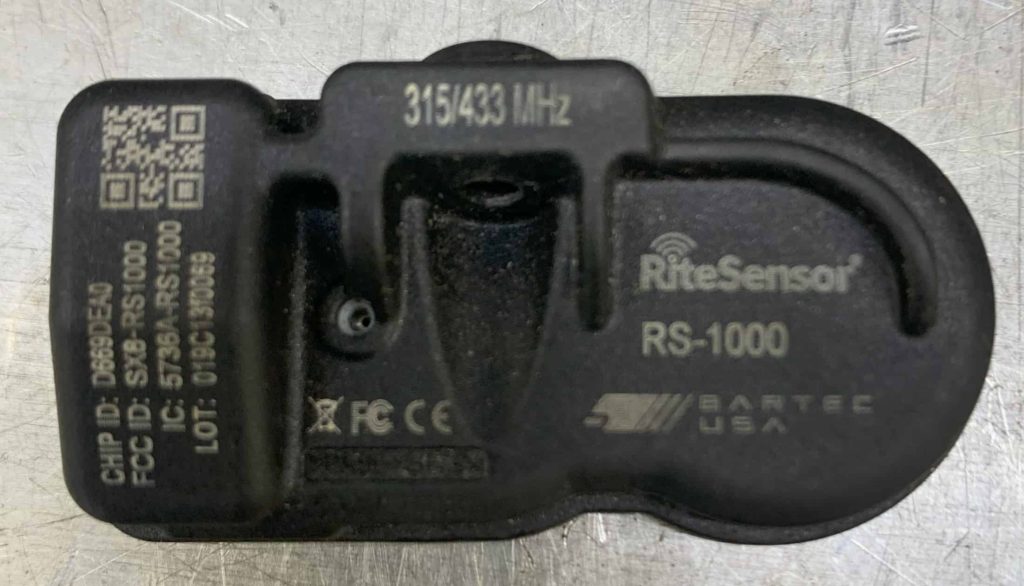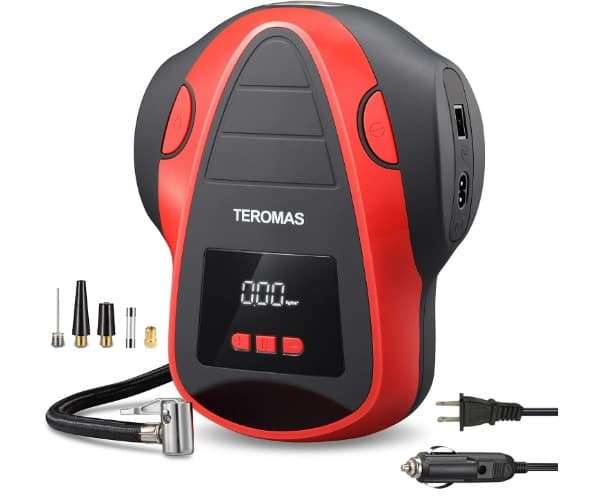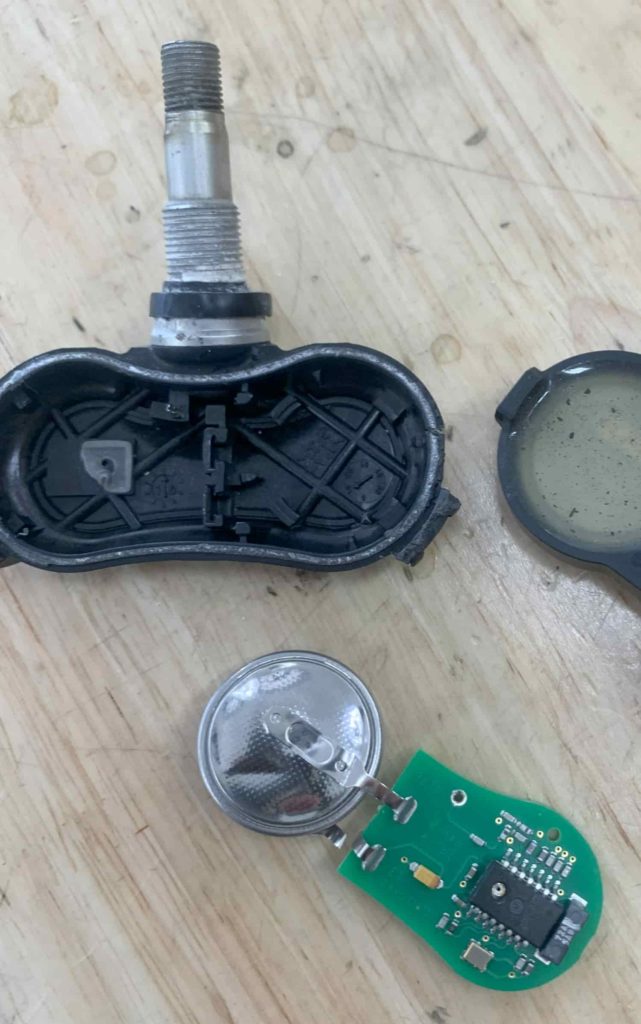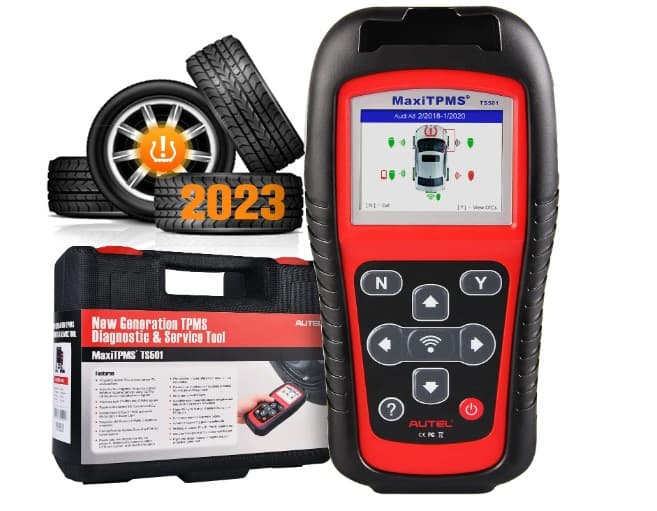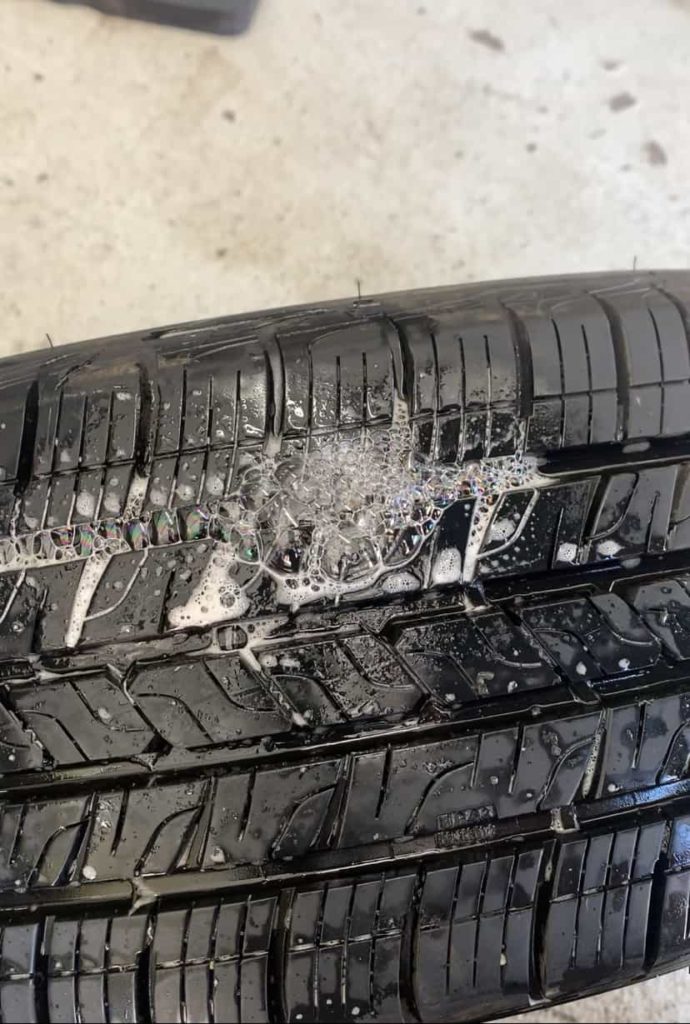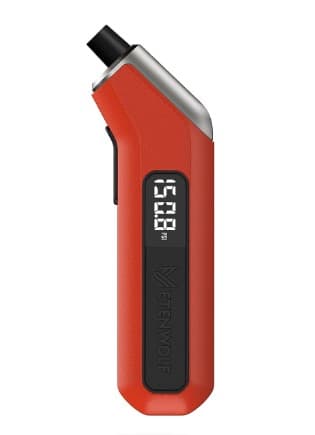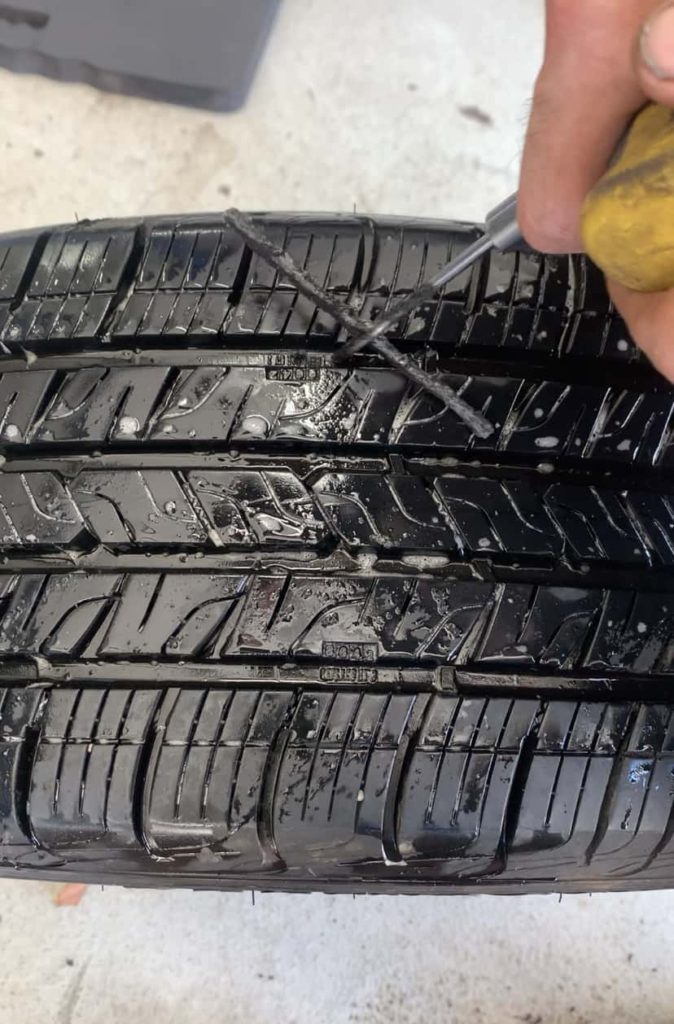What is the Ford Fiesta Tire Pressure Monitoring System?
The TPMS in the Ford Fiesta, which stands for Tire Pressure Monitoring System, comprises sensors mounted in each tire, a dedicated receiving module, and a primary computing unit called the ECU. This integrated system is designed to warn the driver of any problematic tire pressure levels, while also self-assessing for any malfunctions within the TPMS itself.
How Does the Ford Fiesta TPMS Work?
Sensor-Enabled Tire Metrics: Every valve stem in the Ford Fiesta has a sensor connected to it inside the tire (it’s not visible without taking the tire off the wheel). These specialized sensors continually gauge both the air pressure and temperature once the vehicle reaches a speed of 20 mph or more. Each sensor is a small circuit board that is battery-operated and encased in a compact plastic shield.
Wirelessly Transmit Tire Data: During driving the sensors are collecting data and transmitting it to the TPMS receiver using a transmitter and an antenna. They operate on either 315 MHz or 433 MHz frequencies.
Onboard TPMS Receiver: Located within the Fiesta is a supplementary microcomputer that captures the sensor-emitted wireless signals from the sensors. After receiving the information, it forwards it to the primary ECU for further scrutiny.
ECU Analysis: The vehicle’s central computer (Electronic Control Unit) reviews the incoming pressure and temperature metrics and evaluates the numbers. A warning gets initiated if the tire pressure descends 15-20% below Ford’s suggested levels.
Dashboard Notifications: If the ECU detects tire pressure below the set parameters, a yellow exclamation mark warning light is triggered on the dashboard to alert the driver of the problem.
Ford Fiesta Low Tire Pressure Reset Procedure
Park the Ford Fiesta: Park the Fiesta on level ground.
Measure and Adjust Pressure: Examine and inflate or deflate tire pressures when the tires are cold to the exact recommended pressures.
Drive: Drive the Ford Fiesta for several minutes at a speed above 20 Mph.
Ford Fiesta Tire Pressure & Wheel Size
TIRE SIZE | FRONT PSI | REAR PSI |
185/60R15 | 32 | 32 |
195/50R16 | 35 | 35 |
205/40R17 | 39 | 39 |
What Will Trigger the Ford Fiesta Low Tire Pressure Light?
Tires with inadequate air levels
Excessively inflated tires
Tires losing air pressure
Lack of sensor in the wheel (like when a spare is being used)
Unreliable or drained sensor battery
Malfunctioning TPMS receiving module or vehicle computer
Electronic interference from nearby Ford vehicles or devices
Environmental or altitude changes
Extreme vehicle load weight
Heavy duty window tints
Ford Fiesta Tire Pressure Sensor Batteries
All 4 wheels of the Ford Fiesta have their own tire pressure sensor and each sensor is powered by its own silver-oxide battery (the batteries look very similar to those in wrist watches or key fobs). Each sensor is made up of a circuit board, a battery, and a plastic case. The battery is directly connected to the circuit board. Due to the sensor’s design, merely changing the battery isn’t feasible so the entire sensor unit has to be replaced when the battery dies. Ford’s tire pressure sensors usually last anywhere from 5 to 10 years, or can go up to an estimated 100,000 miles.
Troubleshooting the Ford Fiesta
Should the tire pressure light in your Ford Fiesta fail to extinguish or reset, consider these six possible remedies to diagnose and address the issue.
SOLUTION 1: Is One or More Tires Losing Air?
If your Ford Fiesta’s tire light activates, the first course of action is to pull over and check out the tires. Inspect all the tires and measure their pressures to figure out which one is lacking proper air pressure. To verify if there’s a leak in your Ford Fiesta tire, proceed with the following:
Gauge the pressure levels of all tires to identify the deflated one.
Use a tire inflator to replenish the air in that particular tire.
Drive the Fiesta for a brief period at speeds exceeding 20 mph.
Answer: Should the tire light switch off after you’ve added air and driven the car but reappears later (whether it’s minutes, hours, or days), you can safely assume that the specific tire or wheel you added air to has a leak. To locate where the air leak is precisely, consult solution 6.
SOLUTION 2: Reset the Diagnostic Trouble Codes (DTC) in the Ford Fiesta ECU
Every time the low tire pressure light is activated, this event is stored in the Ford Fiesta’s ECU as a Diagnostic Trouble Code (DTC). Similar to how you’d reboot a frozen computer to resolve temporary issues, you can “restart” your vehicle to erase such DTCs. To do so, cut off the ECU’s power supply by disconnecting the negative lead of the main 12-volt battery (make sure to turn off the ignition and all electronic devices), wait for a few moments, and then reconnect it. Once the power is back on, we recommend taking the car on a 30-minute drive at a consistent speed of 50 mph.
Answer: Should the tire pressure light extinguish after this process but illuminate again later while driving or afterward, this could mean that one or more of your tire pressure sensors are faulty (commonly due to battery issues) or there’s a leak in one or more tires or wheels.
SOLUTION 3: Use a TPMS Diagnostic Tool to Find a Faulty Tire Sensor
Should the tire light illuminate or flash accompanied by messages like “Tire Pressure Sensor Fault” or “Tire Pressure Monitor Fault,” this signifies that at least one tire pressure sensor is not operating correctly. To pinpoint the problematic sensor, each one can be individually assessed using a TPMS diagnostic tool.
Connect the TPMS tool to the Ford Fiesta’s OBD2 outlet.
Position the TPMS tool immediately in front or next to the front left wheel’s valve stem and press “test” or “trigger” on the tool.
Wait for the instrument’s feedback before moving on to evaluate the other three tires.
Answer: After conducting tests on each of the Ford Fiesta TPMS sensors, the TPMS diagnostic tool will provide an overview of each sensor’s status. If the diagnostic tool is unable to make contact with a sensor or indicates that its battery is low or dead, that particular sensor should be swapped out with a new one.
SOLUTION 4: Trigger an Unresponsive Tire Pressure Sensor
Occasionally, tire pressure sensors can be hard to calibrate and may need a more forceful technique for resetting. If your attempts to reset and retrain the Ford Fiesta’s TPMS sensors haven’t worked, we advise taking these measures:
Release 15-20 Psi from the troublesome tire by softly pressing the valve stem core.
Wait for a short period.
Exceed the Ford’s suggested tire pressure by 5 Psi when filling the tire. (If the recommended pressure is 30 Psi, pump it up to 35 Psi.)
Take the car on a brief spin at speeds above 20 mph.
After the drive, adjust the tire pressure back to its recommended cold settings.
Answer: Should this method prove ineffective in turning off the tire pressure light, we suggest you complete solution 4 and then follow the prescribed steps for resetting the Ford Fiesta tire pressure light.
SOLUTION 5: The Tire Light Automatically Cycles On and Off
The effect of cold tires on air pressure is commonly underestimated. Have you ever seen the tire light in your Ford Fiesta come on when you first start your day or after the vehicle has been idle for a while, and then switch off as you start to drive or as the climate warms? This is because cold tires naturally lose some air pressure, whether from being stationary or influenced by the weather. This is often the reason why low tire pressure indicators are triggered.
Answer: For the most accurate tire pressure settings, as per Ford’s guidelines, ensure you check and adjust your tires when they are in a cold state.
SOLUTION 6: Determine Where the Tire is Leaking From
Once you’ve determined which tire is leaking air, it’s crucial to discover the specific leak location. You will need a spray bottle filled with a soap and water mixture, as well as a tire inflator for this procedure.
Pump up the tire in question to at least 40 Psi.
Fill the spray bottle with a generous blend of soap and water, and spray it thoroughly over the tire’s surface.
Search for bubbles forming on the tire, as these will reveal where the air is escaping from.
Answer: Spot the bubbles, and you’ve found where the tire is compromised.
The Air Temperature Impact on Tire Pressure
Seasonal changes and air temperature have a measurable impact on the tire pressure of a Ford Fiesta. Research shows that for a 10°F variation in temperature, a tire can experience a pressure change of around 1-2 psi. This is especially significant in winter months, when night temperatures greatly differ from day temperatures, or in geographic locations where the temperature varies widely within short periods of time.
Ford Fiesta Tire Questions
How to Check The Ford Fiesta Tire Presure
Initial Observation: Prior to taking any actions, we recommend doing a brief stroll around the vehicle to examine the tires quickly.
Preparation: Acquire an accurate tire pressure gauge. We recommend Digital gauges because they are accurate and easy to read.
Park & Turn Off: Park the Ford Fiesta on level ground and turn off the engine.
Time for Cool Down: For best results, ensure the tires are cold. For best results, if possible, wait 3 hours for the tires to cool off completely.
Access Valve Stem: Locate and unscrew the valve stem cap.
Gauge Reading: Use the digital pressure gauge to measure the tire’s pressure.
Refer to Door Sticker: Open your Ford Fiesta driver side door and check the tire pressure sticker for Ford’s recommended tire pressure.
Make Adjustments: Either inflate the tire using an air inflator or release some air to meet the recommended levels. Check the pressure after adjusting.
Seal the Valve: Don’t forget to put the valve stem cap back on!
Check Every Tire: Repeat these steps for all tires.
Is it Safe to Drive the Ford Fiesta With the Tire Light On?
If the tire pressure warning light comes on, stop driving at once and evaluate the problem. Visually inspect the tires and check their pressure levels. Continuing to drive with the warning light illuminated can pose a safety hazard. We suggest determining why the light is on because it will help you understand how unsafe it could be.
Why is the Ford Fiesta Tire Light Flashing?
A flashing tire pressure light in the Ford Fiesta usually indicates that one or more tire pressure sensors are not successfully sending data to the car’s ECU or the TPMS receiver module. This condition is known as a TPMS malfunction. The most common reasons for this include a sensor having a low or dead battery or the absence of a sensor in one or more wheels. For example, the spare tire in the Ford Fiesta does not have an embedded sensor, which means it’s not sending any data to the car’s computer. The warning light will blink and then remain illuminated each time you use the car until you resolve the issue.
Should You Use Tire Plugs to Fix Tire Punctures?
Yes, tire plugs offer a reliable solution for fixing punctures in tires, and I find them trustworthy in most conditions. They are not suitable for tires with severely low tread or for repairing the sidewall.
Will Tire Sealants Damage the Tire Pressure Sensors?
Tire sealants pose a risk of damaging tire pressure sensors and can also result in tire imbalance. We advise reserving their use for emergency situations only!
Please note that this blog post contains Amazon affiliate links. This means that if you make a purchase through one of these links, we at TPMSRESET.COM may earn a small commission at no extra cost to you. We only recommend products that we personally use and believe in. Thank you for supporting us.

